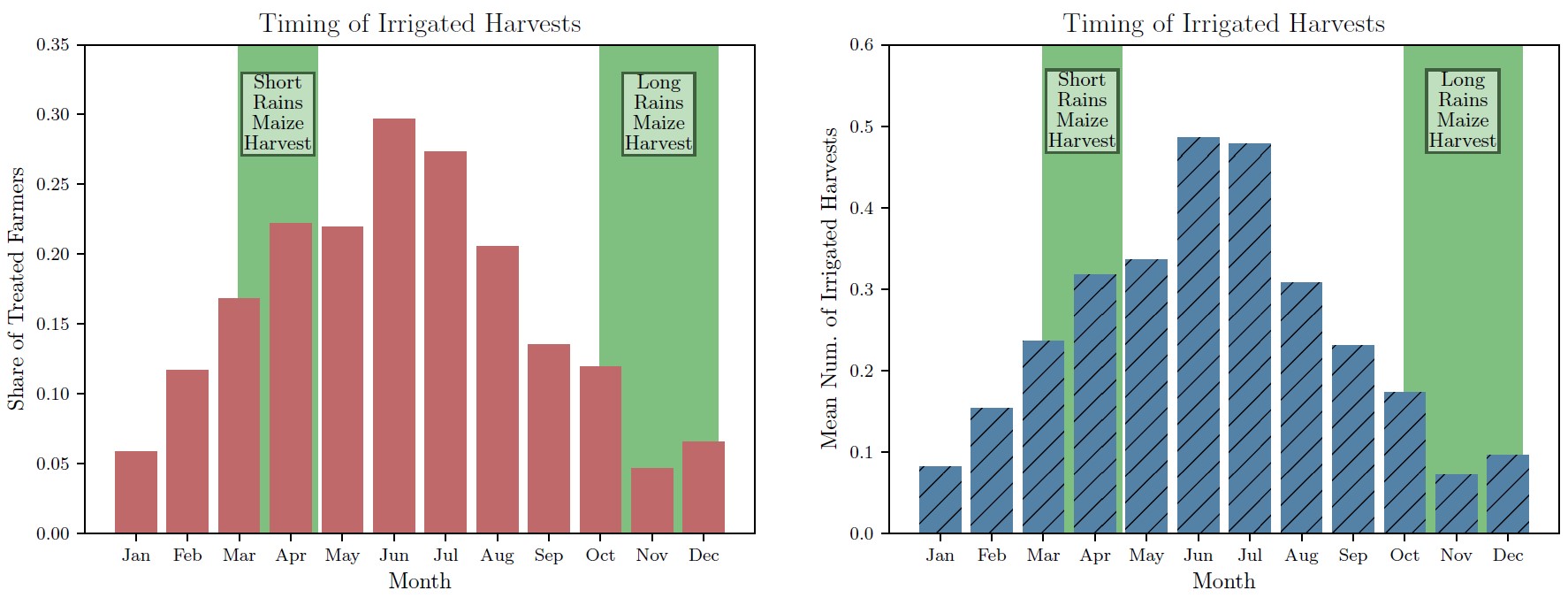
Small-scale irrigation pumps in Kenya provided both economic and non-economic benefits to smallholder farmers, and improved the position of women in the household
Smallholder farmers in Sub-Saharan Africa are facing the significant twin challenges of stagnating technological progress and increasingly disruptive climate shocks. Understanding how individuals and governments can adapt to climate change is a growing area of research (Kala et al. 2023), and given these growing climate-related risks, understanding the effect of technologies that can improve productivity and increase resilience is a pressing issue. This is especially true for small-scale interventions that can avoid the problems faced by large scale, public investments (Suri and Udry 2022). For all these reasons, small-scale irrigation pumps have significant potential.
While there has been recent work by Cohen et al. (2022) showing that a bundled intervention including this type of irrigation pump (along with seeds, fertiliser, and agricultural and financial training) improved food security and improved mental health, there is less rigorous evidence available on the effect on agricultural incomes, and whether this is a profitable investment for farmers.
Our study
To address this knowledge gap, we conducted a randomised impact evaluation of household irrigation pumps across three counties in Kenya (Dyer & Shapiro 2023). Irrigation pumps were given out free of charge to smallholder farming households identified by our local partner that had sufficient access to water for the pumps to function. These pumps were allocated by public lotteries held at central locations, after short information sessions explaining how to use the pumps, attended by both treatment and control farmers. At the time, the price of these pumps was approximately 100 USD. This was a relatively light-touch intervention, requiring minimal institutional or technical capacity to implement, highlighting how this agricultural technology is appropriate to the context and also scalable. In addition, we wanted to explore whether transferring a productive asset to the household could impact decision making and women’s empowerment in the household. For this reason, the pumps were allocated to the primary woman in the household. Where she was not able to attend, the pump was allocated to another household member and a mobiliser called the household to clarify the pump belonged to the woman in question.
We wanted to explore how irrigation pumps impact agricultural income and asset holdings, food security, and non-economic effects such as mental health and women’s empowerment. In particular, we wanted to explore how irrigation impacts agricultural production, by looking for effects on the extensive margin (through expanded cultivation) and on the intensive margin (through increased productivity per unit of land cultivated). To answer these questions, we collected detailed survey data on agricultural production and land in the long rains season, the short rains season, and crops grown under irrigation. We also collected information on input spending and self-reported time inputs. We collected data at the baseline information sessions in May-June 2015, prior to the pumps being allocated, and again two years later at endline in August-September 2017.
What are the impacts of irrigation pumps?
Irrigation pumps had a striking effect on agricultural output of smallholder farmers. The total net value of agricultural output is about 4,300 Kenya Shillings higher (approximately 13% of the control mean) for farmers who received the irrigation pumps. This is a significant increase, meaning that the initial cost of the irrigation pump is repaid within three seasons. The impact on household assets was weaker and not statistically significant.
In addition to knowing the effect of irrigation pumps on income, it is important to understand how irrigation impacts production. Irrigation pumps do not appear to have any significant effect on the value of production in the long rains or short rains seasons, and appears to act primarily through the expansion of non-rainfed crops produced under irrigation. Farmers allocated irrigation pumps produced a greater number of crops under irrigation on a greater amount of land, with no significant differences for the short rains or long rains. As expected, the additional crops grown under irrigation were horticultural crops such as kale, tomatoes, and spinach. The same pattern exists for cash inputs and time, where households allocated irrigation pumps invest significantly more time and spend more on inputs for their irrigated crops, though there is a negative and weakly significant effect of irrigation pumps on the time they spent per unit of irrigated land. This is all consistent with irrigation acting by expanding irrigated production with no significant effect on rainfed production. This is consistent with the timing of irrigation which fell in between the normal harvest times for maize in each of the main rainfed seasons.
Figure 1: Timing of irrigated harvests: The bulk of irrigated harvests do not occur at the same time as the main rainfed maize harvests, suggesting that irrigation primarily acts through additional seasons

Given that irrigation pumps appear to increase overall agricultural production, without any significant effect on rainfed agriculture, it is important to understand how this impacts non-agricultural income. We find that households with irrigation are significantly less likely to have had any casual or wage earnings off-farm, which suggests that resources are being reallocated from non-agricultural production to increased irrigated farming. This is consistent with a weakly significant reduction in earnings from non-farm enterprises.
Overall, the evidence suggests that irrigation pumps significantly increase agricultural income on the extensive margin (increased land under cultivation) and reallocation of resources away from off-farm activities. Given the importance of agriculture for livelihoods, it is natural to wonder if these benefits extend to non-economic outcomes. The evidence suggests that irrigation pumps do improve mental health, specifically with improved self-esteem and reduced depression, measured using standard validated psychometric scales.
Reallocation within the household?
So far, we have discussed how irrigation impacts the households as whole, rather than how different members of the household are impacted. As an asset like this is of economic significance, who owns and controls the irrigation pump might impact power dynamics within the household. Understanding this type of side-effect is a concern whenever a potential intervention involves allocation of assets. With this in mind, we wanted to explore the effect of irrigation assets of women empowerment within the household. Evidence from this randomised intervention, where pumps were allocated to women, suggests that control of an economically important asset leads to a change in decision making power. Compared to households who were not given pumps, the evidence suggests that women who were allocated irrigation pumps had more influence over household decisions. Some of these effects are mechanical, and simply indicate that women retained control over the pump they were given. There is also evidence, however, that irrigation pumps lead to women participating in household decisions more broadly that aren’t related to use of irrigation pumps, including significant choices like whether to have another child.
Mechanisms and implications
The evidence, therefore, suggests that irrigation pumps are an effective technology, providing economic and non-economic benefits, with the capacity to improve the position of women in the household. It is also important for policymakers to understand how these impacts come about. To make some progress on this, we explore the involvement of women in agriculture prior to having irrigation pumps. We find that when pumps are given to women in households where women were already very heavily involved with agriculture, the income effect is much stronger. For these households, we also find that the effects on farm revenue and psychological wellbeing are also much stronger. For the outcomes measuring empowerment and domestic violence, there is no such difference in treatment effect. While this is only suggestive, it tells us that irrigation pumps owned by women act by two separate mechanisms: one which improves revenue and improves psychological wellbeing, and another which impacts power within households.
References
Craig R. Cohen et al. (2022), ‘Effect of a Multisectoral Agricultural Intervention on HIV Health Outcomes Among Adults in Kenya: A Cluster Randomized Clinical Trial’, JAMA Network Open 5(12).
Dyer, J and J Shapiro (2023), ‘Pumps, Prosperity and Household Power: Experimental Evidence on Irrigation Pumps and Smallholder Farmers in Kenya’, Journal of Development Economics 163: 103034.
Kala, N, C Balboni, and S Bhogale (2023), ‘Climate Adaptation’, VoxDevLit 7.1.
Suri, T and C Udry (2022), ‘Agricultural Technology in Africa’, Journal of Economic Perspectives 36(1): 33–56.


